Battle of Kolubara
The Battle of Kolubara (Serbian Cyrillic: Колубарска битка, German: Schlacht an der Kolubara) was a campaign fought between Austria-Hungary and Serbia in November and December 1914, during the Serbian Campaign of World War I. It commenced on 16 November, when the Austro-Hungarians under the command of Oskar Potiorek reached the Kolubara River during their third invasion of Serbia that year, having captured the strategic town of Valjevo and forced the Serbian Army to undertake a series of retreats. The Serbs withdrew from Belgrade on 29–30 November, and the city soon fell under Austro-Hungarian control. On 2 December, the Serbian Army launched a surprise counter-attack all along the front. Valjevo and Užice were retaken by the Serbs on 8 December and the Austro-Hungarians retreated to Belgrade, which 5th Army commander Liborius Ritter von Frank deemed to be untenable. The Austro-Hungarians abandoned the city between 14 and 15 December and retreated back into Austria-Hungary, allowing the Serbs to retake their capital the following day.
| Battle of Kolubara | |||||||
|---|---|---|---|---|---|---|---|
| Part of the Serbian Campaign of the Balkans Theatre of World War I | |||||||
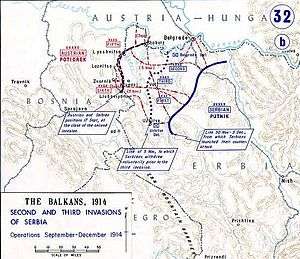 A map depicting the third Austro-Hungarian invasion of Serbia, November–December 1914. | |||||||
| |||||||
| Belligerents | |||||||
|
|
| ||||||
| Commanders and leaders | |||||||
|
|
| ||||||
| Units involved | |||||||
| |||||||
| Strength | |||||||
| 400,000 | 450,000 | ||||||
| Casualties and losses | |||||||
|
| ||||||
Both the Austro-Hungarians and the Serbs suffered heavy casualties, with more than 20,000 dead on each side. The defeat humiliated Austria-Hungary, which had hoped to occupy Serbia by the end of 1914. On 22 December, Potiorek and von Frank were relieved of their respective commands, and the 5th and 6th armies were merged into a single 5th Army of 95,000 men.
Background
On 28 June 1914, Bosnian Serb student Gavrilo Princip assassinated Archduke Franz Ferdinand of Austria in Sarajevo. The assassination precipitated the July Crisis, which led Austria-Hungary to issue an ultimatum to Serbia on 23 July on suspicion that the assassination had been planned in Belgrade.[1] The Austro-Hungarian government made the ultimatum intentionally unacceptable to Serbia, and it was indeed rejected.[2] The Austro-Hungarians declared war on Serbia on 28 July and that same day the Serbs destroyed all bridges on the Sava and Danube rivers in order to prevent the Austro-Hungarians from using them during any future invasion.[3] Belgrade was shelled the following day, marking the beginning of World War I.[4]
Fighting in Eastern Europe began with the first Austro-Hungarian invasion of Serbia in early August 1914, under the command of Oskar Potiorek.[5] The number of Austro-Hungarian troops assigned to the invasion was far smaller than the 308,000-strong force intended when war was declared. This was because a large portion of the Austro-Hungarian 2nd Army had moved to the Russian Front, reducing the number of troops involved in the initial stages of the invasion to approximately 200,000. On the other hand, the Serbs could muster some 450,000 men to oppose the Austro-Hungarians upon full mobilization. The main elements to face the Austro-Hungarians were the 1st, 2nd, 3rd and Užice armies, with a combined strength of approximately 180,000 men.[6] The Serbian Army was commanded by Crown Prince Alexander, with the chief of the Serbian general staff, Radomir Putnik, as his deputy and de facto military leader. Petar Bojović, Stepa Stepanović, Pavle Jurišić Šturm and Miloš Božanović commanded the 1st, 2nd, 3rd and Užice armies, respectively.[5]
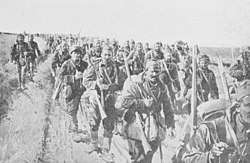
The Balkan Wars had only just concluded and Serbia was still recovering. Over 36,000 Serbian soldiers had been killed and 55,000 seriously wounded. Few recruits had been gained from the newly acquired territories, and the Serbian Army had been stretched by the need to garrison them against Albanian insurgents and the threat of Bulgarian attack. To compound matters, the Serbs were dangerously short of artillery, and had only just begun to replenish their ammunition stocks. Their supply problems also extended to more basic items. Many soldiers lacked any uniform other than a standard issue greatcoat and a traditional Serbian cap known as a šajkača. Rifles were also in critically short supply. It was estimated that full mobilization would see some 50,000 Serbian soldiers with no equipment at all. The Austro-Hungarians, on the other hand, possessed an abundance of modern rifles and had twice as many machine guns and field guns as the Serbs. They also had better stocks of munitions, as well as much better transport and industrial infrastructure behind them. The Serbs had a slight advantage over the Austro-Hungarians as many of their soldiers were experienced veterans of the Balkan Wars and better trained than their Austro-Hungarian counterparts.[6] Serb soldiers were also highly motivated, which compensated in part for their lack of weaponry.[7]
The Serbs beat back an Austro-Hungarian invasion in August, at the Battle of Cer. It marked the first Allied victory over the Central Powers in World War I.[8][9][10] Potiorek was humiliated by the defeat and was determined to resume the assault against the Serbs. He was given permission in September to launch another invasion of Serbia provided that he "[did not] risk anything that might lead to a further fiasco."[11] Under pressure from the Russians to launch their own offensive and keep as many Austro-Hungarian troops as possible away from the Eastern Front, the Serbs invaded Bosnia in September with the help of Chetnik irregulars but were repulsed after a month of fighting in what came to be known as the Battle of the Drina.[12] Bojović was wounded during the battle and was replaced by Živojin Mišić as commander of the Serbian 1st Army.[5]
Prelude
Austro-Hungarian plans
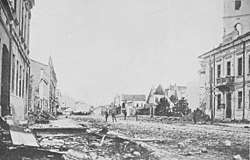
The Armeeoberkommando (AOK) acknowledged that an undefeated Serbia severed Austria-Hungary's connection to the Ottoman Empire and prevented the completion of the Berlin–Baghdad railway. The AOK also realized that the Austro-Hungarian army's inability to defeat Serbia would discourage neutral countries—such as Bulgaria, Romania and Greece—from joining the Central Powers and would tempt Italy to open up a third front against Austria-Hungary.[13] Nevertheless, the AOK was hesitant to authorize a third invasion of Serbia. This changed in September 1914, when Austro-Hungarian troops discovered a map in an abandoned Semlin bookshop, titled The New Division of Europe. Originally printed in a Russian newspaper, the map was widely sold in Serbia and depicted the borders of Europe as they would appear following the war. Germany was to be divided into northern and southern confederations and Austria-Hungary was to be abolished, its eastern provinces given to Russia, Romania, the Czechs and the Hungarians, and its southern provinces divided between Serbia and Italy.[14] Alarmed by the prospect of Austria-Hungary's disintegration, Emperor Franz Joseph personally authorized a third invasion of Serbia in early October 1914.[15]
Having just repelled the Serbian incursion into Bosnia, the Austro-Hungarian Army regrouped and positioned itself for one final invasion before winter set in.[16] Potiorek was again placed in charge of Austro-Hungarian forces and was given command of the Austro-Hungarian 6th Army. The Austro-Hungarian 5th Army was commanded by Liborius Ritter von Frank.[17] In total, the Austro-Hungarians had 450,000 troops at their disposal. The Serbian Army had 400,000 soldiers ready to face the Austro-Hungarian advance.[18] Potiorek appeared confident. "Soldiers of the 5th and 6th armies," he said. "The goal of this war is nearly attained—the complete destruction of the enemy. The three-month campaign is almost over; we must only break the enemy's last resistance before the onset of winter."[19] The Serbs were exhausted and demoralized.[lower-alpha 1] In a telegram to Putnik dated 27 October 1914, Stepanović complained that the 2nd Army did not have enough shells to resist the Austro-Hungarians effectively and requested that he be removed from his command;[lower-alpha 2] Putnik denied the request, but ordered all units to resist the Austro-Hungarian advance for as long as possible before retreating. This strategy had worked in Putnik's favour during the summer months, but heavy rainfall in September and early October had reduced all of Serbia's roads to "muddy quagmires" that made movement of troops, guns and wagons extremely difficult. Potiorek recognized that the Serbian Army was in a difficult situation; he was certain that a third invasion would bring him the decisive victory that he so desperately wanted.
In Vienna and Sarajevo, Austro-Hungarian officials began planning for the occupation and dismantling of Serbia. The country was to be plundered and its territory used to bribe the neutral Balkan states into joining the Central Powers, with the Romanians getting the region of the Timok Valley and the Bulgarians getting Macedonia and southeastern Serbia. The Austro-Hungarians intended to annex everything west of the Morava River, as well as the cities of Scutari (Shkodër) and Durazzo (Durrës) in northern Albania.[15] The Serbs living west of the Morava—or "the compact masses of the Serbian element", as the Austro-Hungarians called them—were to be expelled and replaced with Austrian settlers (colonisten), who would "change the psychology [of the region], making Serbia more Habsburg [and] less Serbian in outlook." Ludwig Thallóczy, section chief of the Austro-Hungarian Finance Ministry, wrote Potiorek in October, recommending "the West Europeanization of the Serbs with a strong hand" as soon as Serbia was occupied.[19]
Potiorek planned to launch a converging attack across northern and western Serbia; the 5th Army was to capture Valjevo and envelope the Kolubara River from the north, and the 6th Army was to secure the Jagodnja plateau and outflank Serbian units on the Kolubara from the south. The capture of the southeastern Serbian city of Niš was Potiorek's main objective; Niš had been Serbia's capital since July and was a crucial transportation hub for its military. It also acted as a clearing house for munitions produced at the arsenal in nearby Kragujevac. The city's capture would effectively cut Serbia in two and scatter the Serbian Army.[20]
Third Austro-Hungarian invasion of Serbia
All of the valleys of northwestern Serbia were swamped by constant rainfall. The mountains had been covered in snow since early October. Acknowledging the opportunity that such conditions presented, Putnik told his closest advisors: "All my strategy consists in placing the 'Serbian national mud' between the enemy's fighting line and his supplies."[21] On 31 October, von Frank's 5th Army pushed down into the region between the Sava and Drina rivers while Potiorek's 6th Army drove west across the Drina and into the Jagodnja plateau.[17] Austria-Hungary's third invasion of Serbia commenced on 6 November 1914, with intense artillery fire strafing a series of Serbian border towns.[16] On 7 November, the Austro-Hungarian 5th and 6th armies attacked across the Drina. Outnumbered and in desperate need of ammunition, the Serbian Army offered fierce resistance but was forced to retreat. The 3rd Army fell back against a road by the Jadar River in an effort to block the Austro-Hungarian advance towards Valjevo, while the 1st Army retreated southward into the Serbian interior and the Užice Army managed to prevent the Austro-Hungarians from crossing the Drina.[22]
On 8 November, the Austro-Hungarians attacked the Serbian 2nd Army near Cer Mountain and came within 1.6 kilometres (0.99 mi) of the Serbian frontline, entrenching themselves at the foot of the mountain.[22] The 2nd Army was given orders to hold the Austro-Hungarians down for as long as possible and, if its position became untenable, retreat towards the right bank of the Dobrava River and position itself so as to block the approach to Valjevo. Elsewhere, the Austro-Hungarians drove a wedge between the 1st and 3rd Army and forced another Serbian retreat.[23] Later that day, the Serbian Government held a joint session with the Serbian Supreme Command with regard to Serbia's worsening military position. Putnik stressed that it was critical for Serbia to hold the Kolubara and the towns within its vicinity and suggested that the Serbs make a separate peace with Austria-Hungary if this proved impossible. This notion was rejected by the Prime Minister of Serbia, Nikola Pašić, who urged further resistance to the Austro-Hungarians and threatened the resignation of his government if peace discussions began. The session ended with the Serbian Government and Supreme Command agreeing to fight on.[16]
Serbian retreat
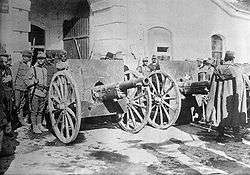
Putnik reasoned that Austro-Hungarian supply lines would become overstretched as their forces pressed deeper into Serbia while the Serbs would continue to hold the railheads in the Serbian interior.[23] On 10 November, he ordered a general retreat from the Jadar and withdrew the Serbian 2nd Army to Ub and positioned the 1st and 3rd armies north and west of Valjevo.[24] Meanwhile, the Užice Army took up positions to defend the town from which it took its name.[23] The Austro-Hungarians pressed after the Serbs, hoping to capture the Obrenovac–Valjevo railroad. Clashes ensued and the Serbian Army managed to prevent the Austro-Hungarians from taking the railroad for a time.[24] It quickly became clear to Putnik that he had underestimated the Austro-Hungarians, who managed to bring their heavy artillery through the muddy Serbian country roads. They established firing positions on the Serbian side of the Drina and began targeting the Serbian Army, which suffered heavy casualties. Morale plummeted amongst the Serbs, who were already significantly demoralized due a lack of cold-weather clothing and ammunition and exhausted by the long retreat towards the Serbian interior. Putnik realized that his forces would need to regroup if they were to provide effective resistance. He ordered that Valjevo be abandoned and had the Serbian Army take up positions on the Kolubara.[23] The retreat towards the river was long and excruciating, with the Serbs being forced to destroy all bridges and telephone lines so that they would not fall into Austro-Hungarian hands. The Serbian Army also abandoned most of its heavy equipment to speed up the withdrawal.[25] Seeing that the situation was critical and that Serbian forces were lacking artillery, ammunition and supplies, Pašić sought the help of the Triple Entente. He sent a telegram to his envoys abroad, which read: "Urgent help is required. Beg and plead."[26] France provided the Serbs with munitions and supplies. Representatives of Russia and the United Kingdom "expressed understanding", but those countries failed to deliver weapons and munitions.[27]
The Austro-Hungarians entered Valjevo on 15 November, prompting wild public celebrations in Vienna.[23] Franz Joseph praised Potiorek for seizing the town; cities across the empire made Potiorek an honorary citizen and Sarajevo even named a street after him.[17] Valjevo's capture led the Austro-Hungarians to believe that they were on the verge of defeating Serbia and that the Serbian Army was no longer a coherent fighting force, but the scorched earth tactics employed by the Serbs during their withdrawal complicated the Austro-Hungarian advance. Although the Austro-Hungarians were right in assuming that the Serbian Army was exhausted, its defensive positions along the Kolubara had been prepared months in advance.[25] Putnik's carefully timed withdrawals had ensured that the losses of the Serbian Army were lighter than if it had stood and fought pitched battles with the Austro-Hungarians. Moreover, the geography of northwestern Serbia favoured defensive operations since the approaches to the Kolubara did not offer any cover to armies invading from the direction of Austria-Hungary and the river itself was surrounded by mountainous terrain. In October, the Serbs had fortified the Jeljak and Maljen mountain ranges in anticipation of an Austro-Hungarian attack. This gave them an advantage over the Austro-Hungarians as it placed them in control of all roads leading to Kragujevac. The Serbs also established a series of field fortifications blocking the approach to Niš.[25] The extensive series of fortifications and the difficulty of the terrain which they faced left the Austro-Hungarians with no choice but to conduct operations in the gruelling Serbian countryside with almost no lines of communication.[28]
Battle
16–26 November
The Austro-Hungarians reached the Kolubara on 16 November and launched an assault against Serbian defensive positions there the following day. The Serbs managed to force the Austro-Hungarians back and over the course of the next five days, the two armies fought a series of battles under heavy rain and snowfall. Both sides suffered heavy casualties, with a large number of soldiers succumbing to frostbite and hypothermia.[29]
The Austro-Hungarian assault began at Lazarevac, a strategically located town just south of Belgrade whose capture would have given them access to the Mladenovac railway line and the ability to outflank the Serbian forces holding the road to Belgrade. Further south, the Austro-Hungarians attacked the Serbian 1st Army. During this assault, they made the mistake of attacking its stronger right flank and were met with determined Serbian resistance which prevented them from gaining any ground. Military historian David Jordan notes that had the Austro-Hungarians attacked the junction splitting the 1st and Užice armies, they might have been able to split the Serbs down the centre and gotten hold of an unimpeded passage to the Morava River. The Serbian 1st Army was quick to reinforce its left flank, realizing that any subsequent attack against it would be far less easy to repel.[29]
During the night of 18 November, the Austro-Hungarians moved into position to carry out a further assault, which began the following morning.[29] The Austro-Hungarians' main goal was to break through the defenses of the Serbian 2nd Army, concentrated primarily around Lazarevac, and to drive the Serbian 1st Army back towards the town of Gornji Milanovac while simultaneously assaulting Serbian positions around the villages of Čovka and Vrače Brdo which threatened the Austro-Hungarian flank.[30] The Austro-Hungarians gained a foothold at Vrače Brdo by the evening of 19 November, and seized higher ground from the Serbs further to the south. The Serbian 1st Army was forced to retreat the following day, giving the Austro-Hungarians the ability to advance down the main routes leading to Kragujevac. Potiorek believed it was possible that Putnik was trying to lure the Austro-Hungarians deeper into Serbia for the purpose of encircling them and then attacking their flanks, but correctly assessed that the Serbian Army was in no position to carry out such an attack.[31]
The Austro-Hungarians made a renewed attack against the 1st Army on 21 November, forcing the Serbs back after a series of brutal engagements. The Austro-Hungarians then advanced towards Mount Maljen, aiming to drive the 1st Serbian Army from its positions there. The Serbs withdrew from the mountain after three days of heavy fighting; Potiorek decided not to pursue, allowing them to make an orderly withdrawal. The Austro-Hungarians had suffered heavy casualties and the intensity of the fighting caused them to lose cohesion. As they advanced deeper into Serbia, the terrain became increasingly difficult and exhausted the already tired Austro-Hungarian soldiers. While the Serbian 1st Army withdrew, the 2nd and 3rd armies fiercely resisted the Austro-Hungarian advance.[31] This led Potiorek to reinforce his positions around Lazarevac, which he aimed to capture and use as a pivot from which to attack Kragujevac while his right flank pushed down the West Morava valley. Austro-Hungarian advances convinced Potiorek that his army had the upper hand. He envisaged that his forces would pursue the surviving soldiers from the Serbian 2nd and 3rd Armies and predicted that the Serbian 1st and Užice armies would be forced to manoeuvre towards Belgrade and Lazarevac, where they would be encircled and destroyed. Combat on the outskirts of Lazarevac intensified once again as a result, and the Serbian Army managed to repulse every Austro-Hungarian assault despite a lack of ammunition. The Serbs began to run out of shells and Stepanović asked the Serbian Supreme Command that the artillery of the 2nd Army be redirected to its rear, as he felt that its failure to contribute to the defense of Lazarevac frustrated his troops and was bad for morale. Putnik instructed Stepanović to keep the artillery of the 2nd Army on the front and told him that the Russians had sent artillery shells for its guns. Stepanović was skeptical, but kept the artillery on the front line as instructed.[32]
By 24 November, Potiorek was predicting that Serbia would be defeated within a matter of days and appointed Stjepan Sarkotić to be the country's governor once it was occupied.[17] The Austro-Hungarians made further gains on 25 November, forcing the Serbian Army from Čovka and Vrače Brdo with an intense artillery bombardment. On 26 November, they attempted to cross the Kolubara at its junction with the Sava River and managed to do so in their initial attack. The Serbs soon counterattacked and forced the invaders back, inflicting 50 percent casualties on the Austro-Hungarians and causing their offensive to grind to a halt. On 27 November, the Serbian Army attacked Čovka and Vrače Brdo and succeeded in forcing the Austro-Hungarians out.[32]
Fall of Belgrade
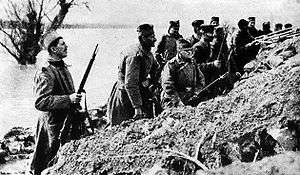
Although the Serbian Army had put up fierce resistance and inflicted heavy casualties on the Austro-Hungarians, Putnik became concerned that his lines were over-extended. He began contemplating another strategic withdrawal, one in which Belgrade would have to be evacuated. On the night of 26–27 November, the Austro-Hungarian 6th Army attacked all along the front and pushed deeper into the Serbian interior.[32]
Defending along an over-extended front, the Serbian Supreme Command decided to abandon Belgrade. The city was evacuated on 29/30 November. The Austro-Hungarians entered the city on 1 December, prompting yet more celebrations in Vienna.[32] The Serbian people withdrew alongside their army and many retreated to Niš, where news of Belgrade's fall was greeted "impassively", as it had been "expected since the beginning of the war". Albin Kutschbach, a German agent in Niš, reported: "More refugees are arriving by the day, and despite many people being sent on south, there are certainly still 60,000 people here." Germany responded to the capture of Belgrade with delight and sent a congratulatory telegram to the Austro-Hungarian leadership. The Austro-Hungarians ascertained that their war with Serbia would soon be over and began preparing for the country's occupation.[27] On 2 December, the anniversary of Franz Joseph's 66th year on the throne, Potiorek wrote that he was "laying town and fortress Belgrade at His Majesty's feet".[33]
Serbian counterattack
It became increasingly clear to both Potiorek and Putnik that Austro-Hungarian supply lines were over-extended and so, on 1 December, Potiorek ordered the Austro-Hungarian 6th Army to stop and wait for the 5th Army to secure its supply lines east of the Valjevo railway, resulting in a short pause to all Austro-Hungarian military operations.[32] Mišić exploited this brief respite by withdrawing the Serbian 1st Army a full 19 kilometres (12 mi) from the front line[24] and ensured that his soldiers had an opportunity to rest.[34] The Serbian Army then converged around Mount Rudnik, where it received long-promised supplies from its allies via the Niš–Salonika railroad. Putnik's confidence in the ability of his army to launch a counterattack was restored.[34]
On 2 December, he ordered his forces to attack the Austro-Hungarians all along the front and informed his officers that the offensive was to have the specific purpose of improving Serbian morale.[32] Determined to play his part, the aging Serbian king, Peter I, took a rifle and accompanied his troops to the front.[34] The Serbian offensive caught the Austro-Hungarians by surprise, and at the time that the attack was launched they were holding a large military parade through the streets of Belgrade.[27] The Austro-Hungarians now found themselves defending along an over-extended front as Potiorek had just begun strengthening his left flank, leaving the front line very lightly held. Potiorek knew that he could avoid a serious reversal on the battlefield by preventing the Serbian 1st Army from reaching the watershed of the Kolubara and Morava rivers, but the Serbs were confident. They discovered that the Austro-Hungarians had failed to adequately prepare for a Serbian counterattack, as their artillery was positioned well behind the front line. This meant that the Austro-Hungarian defenders would be unable to use their heavy guns to break up any Serbian advance. Rested and resupplied, the Serbs pushed forward towards Belgrade. By the night of 2 December, the Serbian 1st Army pushed several kilometres past Austro-Hungarian lines, taking a large number of prisoners and inflicting heavy casualties on the Austro-Hungarians. The 2nd and 3rd armies captured a number of important positions on high ground, while the Užice Army met fierce resistance but was ultimately able to push the Austro-Hungarians back.[34]
The offensive's initial success served to greatly enhance the morale of Serbian troops, just as Putnik had wanted. Significantly weakened, the Austro-Hungarians did not have time to recover before the offensive resumed the following morning and they were forced into retreat by the end of the day.[35] On 6 December, the British ambassador to Serbia informed the British Government that the Serb offensive was "progressing brilliantly".[27] That day, the Serbian Army had broken the Austro-Hungarians at their centre and on their right flank. Outmanoeuvred, the Austro-Hungarians were forced into a full retreat, abandoning their weapons and equipment as they went.[35] Meanwhile, the Austro-Hungarians attempted to consolidate control around Belgrade. On 7 December, they attacked the right flank of the Serbian Army in the city's outskirts.[36]
On 8 December, the Austro-Hungarians fell back against Užice and Valjevo. The Serbs anticipated that their opponents would entrench themselves and attempt to block the Serbian Army's advance, but the Austro-Hungarians had failed to construct any defensive networks and, as such, were in no position to block the Serbian offensive. The Austro-Hungarians had ensured that Valjevo's defenses were fortified and had laid down artillery plans for the town's defense, but their lack of prior preparation meant that the hills surrounding the town were devoid of any significant defensive positions. The Serbs exploited this weakness by manoeuvring around the hills and encircling the Austro-Hungarians, suffering minimal casualties.[35] The Serbian 3rd Army then broke through the defenses of the 6th Army at Mount Suvobor and stormed Valjevo.[24] In Niš, the Bulgarian ambassador to Serbia reported: "The most improbable news from the battleground, sweet to the Serb ear, has been going around since this morning." He wrote that, in the last three to four days, the Serbian Army had captured one Austro-Hungarian General, 49 officers and more than 20,000 troops, as well as 40 cannon and "huge quantities of war matériel".[27] By 9 December, the Austro-Hungarian counter-offensive around Belgrade lost its momentum and the Austro-Hungarians began to retreat back towards the city centre.[37] One Austro-Hungarian soldier wrote: "We could not have imagined that the Serbs were on our heels, after all we had recently been victorious."[38] On 10 December, the Serbian Army captured the lower reaches of the Drina, forcing the majority of surviving Austro-Hungarian troops to flee across the river.[35] They did not stop until they had crossed the Sava and the Danube and entered the Banat. Very few Austro-Hungarian soldiers made it back into Bosnia.[38]
On 13 December, von Frank informed Potiorek that he considered it impossible for Austro-Hungarian forces to remain in Belgrade for much longer. As a result, Potiorek ordered the Austro-Hungarian forces in the city to withdraw. The Austro-Hungarians left Belgrade on 14 and 15 December and retreated back into Austria-Hungary under the cover of their river monitors on the Sava and the Danube. The Serbian Army re-entered Belgrade on 15 December and was in full control of the city by the end of the following day.[39]
Aftermath
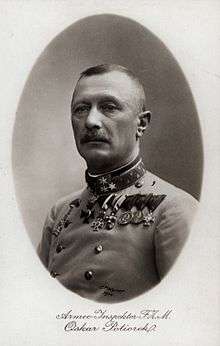

The battle ended in a decisive Serbian victory.[40] A directive issued by the Serbian Supreme Command on 16 December reported: "The recapture of Belgrade marks the successful end of a great and magnificent period in our operations. The enemy is beaten, dispersed, defeated and expelled from our territory once and for all."[38] Franz Conrad von Hötzendorf, the Austro-Hungarian Chief of the General Staff, attributed the defeat to a Serbian "thunder bolt from the south". The battle did not achieve any of Austria-Hungary's objectives: it failed to knock Serbia out of the war, it failed to induce Bulgaria to join the Central Powers and it failed to convince Romania to stay neutral. Austro-Hungarian historians concluded after the battle that defeat by Serbia constituted "a serious diminution in the Dual Monarchy's prestige and self-confidence".[33] The battle, like the Battle of Cer before it, drew considerable attention to Serbia and many foreigners came to the country in late 1914 to offer political and humanitarian aid or to fight alongside the Serbian Army.[10] German publicist Maximilian Harden wrote: "Serbia has risen from its grave on the field of Kosovo. From the source of the Kolubara River it will draw courage for the greatest battles of the whole century."[38]
The Austro-Hungarians suffered about 225,000 casualties, including 30,000 killed, 173,000 wounded and 70,000 taken prisoner.[33] They reported that 200 of their officers were taken prisoner during the battle and more than 130 cannon, 70 heavy machine-guns and a large quantity of matériel were captured.[41] The Serbs also suffered heavy casualties, with 22,000 killed, 91,000 wounded and 19,000 missing or captured.[33] The Western press was appalled with the scale of atrocities committed by the Austro-Hungarian troops against Serbian civilians, including women and children. William Shepard, of the United Press, confirmed as an eyewitness that at least eighteen towns were fully abandoned, and the whole of northwestern Serbia was nearly depopulated.[42]
Mišić was promoted to the rank of vojvoda for his command during the battle.[38] Potiorek, on the other hand, was relieved of command on 22 December for "this most ignominious, rankling and derisory defeat".[33] The decision reportedly made him suicidal.[43] He was replaced by Archduke Eugen of Austria, who the Austro-Hungarians hoped would "restore Habsburg forces to the glory days of Prince Eugene".[33] Von Frank was dismissed as commander of the 5th Army and replaced by Karl Tersztyánszky von Nádas, who had commanded the 4th Corps at the Battle of Cer.[43] The 5th and 6th armies were then merged into a single 5th Army consisting of 95,000 men.[33]
Dobrica Ćosić's novel A Time of Death revolves around the battle.[44] It was adapted into a stage play in 1983, titled The Battle of Kolubara.[45]
Citations
Notes
- Interrogations of Serbian prisoners of war revealed that Serb soldiers had not been fed or paid adequately since the war began. Many prisoners ridiculed Serbian Prime Minister Nikola Pašić for "leading the country into war" and spoke of "regular abuse" at the hands of their "brutal officers". Such comments appear to have convinced Potiorek that the Serbian Army was nearing collapse.[20]
- "We have yet to receive shells; the enemy is bombarding our trenches and we have nothing to fire back. My men are dying under this fire and I have no reserves to replace them with, and no shells to limit the casualties; I thus feel incapable and powerless, and request removal from this command."[15]
Footnotes
- Jordan 2008, p. 16.
- Pavlowitch 2002, p. 93.
- Strachan 2001, p. 335.
- Jordan 2008, p. 17.
- Jordan 2008, p. 21.
- Jordan 2008, p. 20.
- Glenny 2012, p. 314.
- Pavlowitch 2002, p. 94.
- Glenny 2012, p. 316.
- Mitrović 2007, p. 104.
- Jordan 2008, p. 29.
- Strachan 2001, p. 345.
- Wawro 2014, p. 315.
- Wawro 2014, pp. 315–316.
- Wawro 2014, p. 316.
- Mitrović 2007, p. 70.
- Herwig 2014, p. 110.
- Cove & Westwell 2002, p. 153.
- Wawro 2014, p. 317.
- Wawro 2014, p. 318.
- Wawro 2014, pp. 318–319.
- Jordan 2008, p. 33.
- Jordan 2008, p. 34.
- Shrader 2005, p. 643.
- Jordan 2008, p. 35.
- Mitrović 2007, pp. 70–71.
- Mitrović 2007, p. 71.
- Jordan 2008, pp. 35–36.
- Jordan 2008, p. 36.
- Jordan 2008, pp. 36–37.
- Jordan 2008, p. 37.
- Jordan 2008, p. 38.
- Herwig 2014, p. 111.
- Jordan 2008, p. 39.
- Jordan 2008, p. 40.
- Jordan 2008, pp. 40–41.
- Jordan 2008, p. 41.
- Mitrović 2007, p. 72.
- Jordan 2008, p. 42.
- Judah 2000, p. 98.
- Mitrović 2007, pp. 72–73.
- Bataković & Popović 1989, pp. 192–193.
- Buttar 2014, p. 312.
- Wachtel 1998, p. 203.
- Jestrovic 2013, p. 59.
References
- Bataković, Dušan T.; Popović, Nikola B. (1989). Kolubarska bitka (in Serbian). Belgrade: Litera. OCLC 488380587.CS1 maint: ref=harv (link)
- Buttar, Prit (2014). Collision of Empires: The War on the Eastern Front in 1914. Oxford: Osprey Publishing. ISBN 978-1-78200-648-0.CS1 maint: ref=harv (link)
- Cove, Dennis; Westwell, Ian (2002). History of World War I. New York: Marshall Cavendish. ISBN 978-0-7614-7231-5.CS1 maint: ref=harv (link)
- Glenny, Misha (2012). The Balkans: 1804–2012. London: Granta Books. ISBN 978-1-77089-273-6.CS1 maint: ref=harv (link)
- Herwig, Holger H. (2014). The First World War: Germany and Austria-Hungary, 1914–1918 (2 ed.). London: Bloomsbury Publishing. ISBN 978-1-4725-0885-0.CS1 maint: ref=harv (link)
- Jestrovic, Silvija (2013). Space, Performance, Utopia: Cities of War, Cities of Exile. New York: Palgrave Macmillan. ISBN 978-0-230-29266-6.CS1 maint: ref=harv (link)
- Jordan, David (2008). The Balkans, Italy & Africa 1914–1918: From Sarajevo to the Piave and Lake Tanganyika. London: Amber Books. ISBN 978-1-906626-14-3.CS1 maint: ref=harv (link)
- Judah, Tim (2000). The Serbs: History, Myth and the Destruction of Yugoslavia (2nd ed.). New Haven, Connecticut: Yale University Press. ISBN 978-0-300-08507-5.CS1 maint: ref=harv (link)
- Mitrović, Andrej (2007). Serbia's Great War, 1914–1918. West Lafayette, Indiana: Purdue University Press. ISBN 978-1-55753-477-4.CS1 maint: ref=harv (link)
- Pavlowitch, Stevan K. (2002). Serbia: The History of an Idea. New York: New York University Press. ISBN 978-0-8147-6708-5.CS1 maint: ref=harv (link)
- Shrader, Charles R. (2005). "Battle of Kolubara". In Tucker, Spencer (ed.). The Encyclopedia of World War I: A Political, Social, and Military History. Santa Barbara, California: ABC-CLIO. ISBN 978-1-85109-420-2.CS1 maint: ref=harv (link)
- Strachan, Hew (2001). The First World War: To Arms. 1. Oxford: Oxford University Press. ISBN 978-0-19-820877-8.CS1 maint: ref=harv (link)
- Wachtel, Andrew Baruch (1998). Making a Nation, Breaking a Nation: Literature and Cultural Politics in Yugoslavia. Stanford, California: Stanford University Press. ISBN 978-0-8047-3181-2.CS1 maint: ref=harv (link)
- Wawro, Geoffrey (2014). A Mad Catastrophe: The Outbreak of World War I and the Collapse of the Habsburg Empire. New York: Basic Books. ISBN 978-0-465-02835-1.CS1 maint: ref=harv (link)
Further reading
![]()